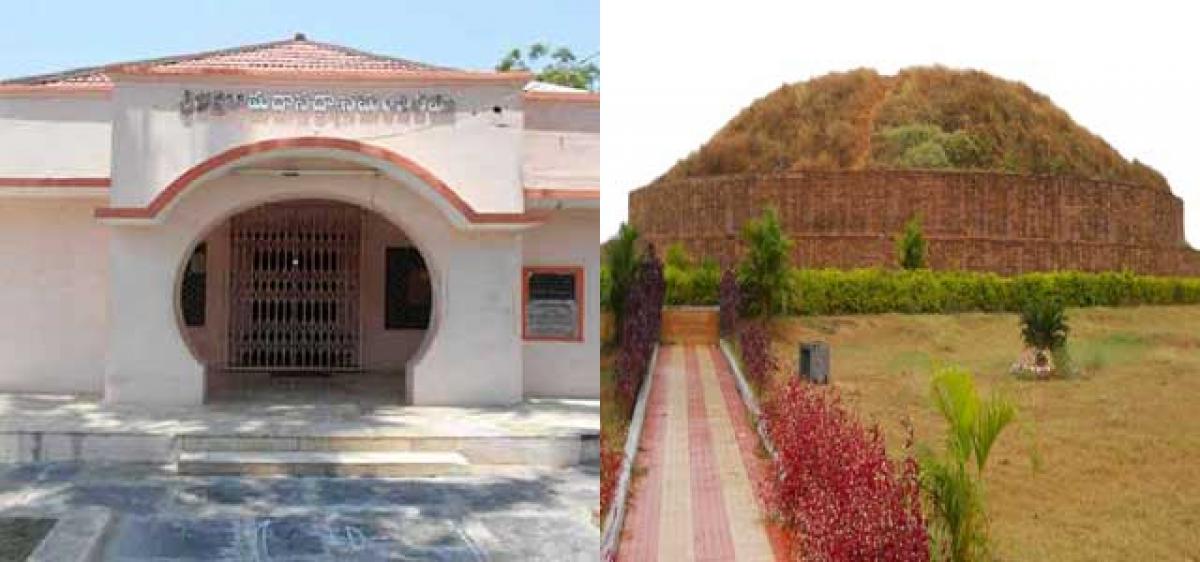Live
- Very few nations have simultaneous polls
- 2 IndiGo planes to bring stranded passengers from Istanbul
- NTR should be awarded Bharat Ratna, says CM
- Vizag mafia rules sand ramps in Srikakulam district
- Unselfishness is a Lie
- ICTPL welcomes maiden vessel MV KSL Fuyang
- BJP leaders mock Rahul's speech
- Analysing Happiness
- Two-day ToT organised for trainers
- Savarkar preferred Manusmriti to Constitution: Rahul
Just In

For most of us Carnatic music students, Nelakondapalli had always been a familiar name. We were taught that it was a small village, which was the birthplace of famous Vaggeyakara, composer Bhadrachala Ramadasu.
The little-known Nelakondapalli, which is 200 km from Khammam has a lot going for it. Nelakondapalli is the birthplace of legendary composer Bhadrachala Ramadasu and it also boasts of important Buddhist monuments and relics, and centuries-old Shiva and Vishnu temples. It is worth visiting by music lovers and history buffs as well as devout Buddhists
For most of us Carnatic music students, Nelakondapalli had always been a familiar name. We were taught that it was a small village, which was the birthplace of famous Vaggeyakara, composer Bhadrachala Ramadasu.
Of course, he was born Kancherla Gopanna and later came to be known as Bhadrachala Ramadasu but that is another story.
Later, I came to know that this place is also an important historic site, which was inhabited in ancient times. Located in Khammam district, and around 25 km from the district capital Khammam city, Nelakondapalli is now a town and mandal headquarters.
It is close to the temple town of Bhadrachalam, which draws lakhs of visitors every year. The Seetharama Temple at Bhadrachalam was constructed by Ramadasu and it was in this region that he lived and composed his melodious and bhaavam-rich compositions aka Bhadrachala Ramadasu keerthanas. They are an important part of the Carnatic music repertoire.
Besides its connection with Ramadasu, Nelakondapalli also boasts important Buddhist monuments and relics, and centuries-old Shiva and Vishnu temples.
Historians say Buddhism flourished in this region with excavations by archaeologists having unearthed the foundations of viharas, a Mahastupa, a bronze idol of Buddha, cisterns, wells, terracotta idols, and a miniature stupa carved in limestone, etc, which they have dated variously to the 3rd and 4th century BC.
A mud fortification wall covers an area of around 100 acres. Locals told us that a Panchaloha idol of Buddha had been found here in the waters by a villager. Several bricks and some more Buddhist relics have been in this area as well as in a nearby lake.
The stupa was quite impressive despite centuries of neglect. We were told that some repairs had been done in recent times by the Archaeology Department.
The red-brick monument has steps, which we ascended to reach the top and get a superb view of the surroundings.
Locals have been calling this mound Virataraju Dibba and the big well, Keechaka Gundam. For the uninitiated, Virat Maharaja was an important character in the Mahabharata and was the king who offered sanctuary to the Pandavas during their one-year period of exile in which they had to remain undetected i.e. in disguise.
Keechaka was his evil brother-in-law who tried to molest Draupadi and was hence killed by Bheema. The locals told us plenty of stories about how the Pandavas lived here and where they practised archery and so on.
I was shown around most of these places by a local family when I went to visit Nelakondapalli for half-a-day, last year with a few friends. I was actually on a visit to nearby Bhadrachalam temple town, for the Bhadrachala Ramadasu music festival conducted here as Ramadasu Jayanthi Prayuktha Vaggeyakara Uthsavam.
This big music event is conducted by the Alivelu Manga Sarvaiah Charitable Trust in collaboration with the Sri Seetaramachandraswamy Devasthanam, Bhadrachalam.
In fact, if visiting Nelakondapalli, the best accommodation option would be Bhadrachalam, which offers a range of hotels, dharmashalas, and dormitories. From here, it would be good to make a day trip to Nelakondapalli.
We also visited the Shiva or Someswara temple and Vaishnavite (i.e. Krishna and Venkateswara) temples, which are fairly well-maintained.
The Rajagopala (a form of Krishna) temple here is believed to be the one which Ramadasu's parents used to visit regularly.
We were told that Ramadasu was born to them as a result of the blessings of this deity and hence the name Gopanna, which refers to Krishna.
Locals told us that we had got darshan at the temples fairly easily. "If you visit during, Dussehra especially Vijaya Dashami, there will be very long queues as this festival draws thousands of people," they said.
As a tribute to its famous son, a Bhakta Ramadasu Dhyana Mandiram has been constructed in Nelakondapalli and Sri Rama Navami, as well as Ramadasu's birth anniversary, is celebrated here annually.
A disappointment was the lack of an archive or music shop where we could buy books or audio records. The lack of clean restrooms around here was also a dampener.
We were shown a well here which was said to be have been used by Ramadasu—there is a sign to that effect beside the well. Further away is a statue of the composer on a fairly large pedestal.
Khammam is around 200 km from Hyderabad and the roads are fairly good though bumpy in parts. The little-known Nelakondapalli has a lot going for it--it is worth visiting by music lovers and history buffs as well as devout Buddhists. We found our visit entirely worth our time and effort.

© 2024 Hyderabad Media House Limited/The Hans India. All rights reserved. Powered by hocalwire.com







